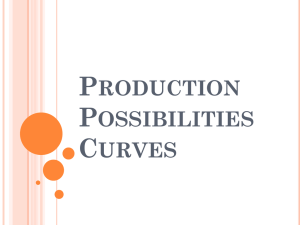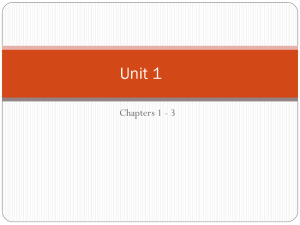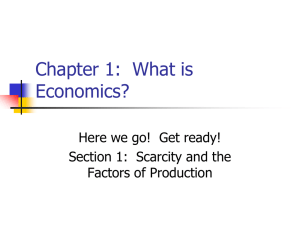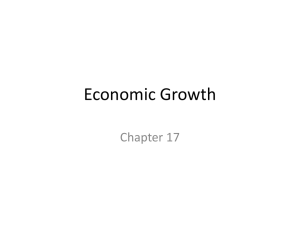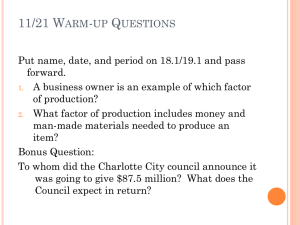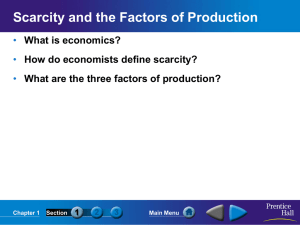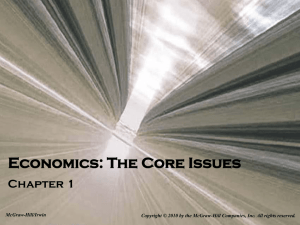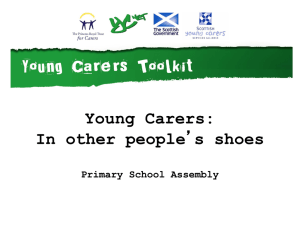Production Possibilities Graph
advertisement
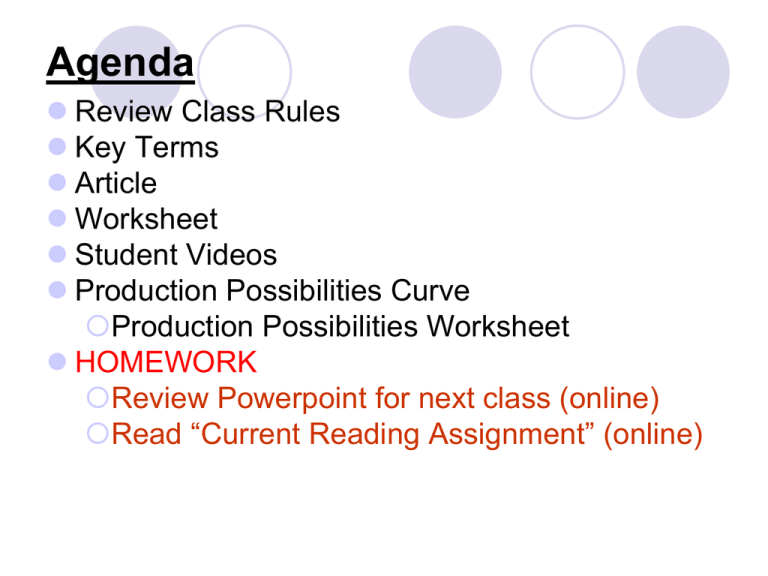
Agenda Review Class Rules Key Terms Article Worksheet Student Videos Production Possibilities Curve Production Possibilities Worksheet HOMEWORK Review Powerpoint for next class (online) Read “Current Reading Assignment” (online) Class Rules Be on time Pay attention Be prepared Don’t use cellphones during class • Comments • You are responsible to monitor your grade • You are responsible to seek help (e-mail is best way to contact me) Being Prepared Do the reading Assigned Print and Review the Powerpoint before class Course Overview – Review Powerpoints introduce the concepts Lectures explain the concepts Readings, videos, movies apply the concepts Course Overview – Review Powerpoints introduce the concepts Lectures explain the concepts Readings, videos, movies apply the concepts So if you don’t review and print the powerpoints before class, success is not likely Course Overview (cont.) Lectures explain the concepts not enough class time to write down all the information contained in the powerpoints Absences You are responsible for… • Getting the material • Reviewing the Class Presentations (posted on Facebook) • Getting the homework assignment, reading assignment, etc. Absences (continued) Tests… You need will make-up the test at detention when you return. You will receive a ZERO if you have not made arrangements and I return the test. E-mail is the best way to make arrangements to take the test. Extra Credit given to the class is everyone attends class on test day. Additional Class Materials Multi-Colored pens (or pen) One inch three ring binder Laptops, kindles, iPads, etc. Yes, you can use them. Module 1 – What is Economics? Economics is the study of human behavior. How people allocate limited resources to produce goods and services to satisfy unlimited needs and wants. Key terms Factors of Production Scarcity vs. shortage Need vs. want Good vs. Service Trade-off vs. Opportunity Cost Entrepreneur Four Factors of Production (resources) 1. Land All Natural resources Example - Oil, Coal, Trees 2. Labor People producing a good or service Example – Auto worker, Lawyer, Teacher 3. Human Capital • Training for Labor Example – College Education, Seminars 4. Physical Capital Tools used by labor to make goods and services Example – Computers, Buildings, Factories, desks Definition of Economics….The study of human behavior. How people allocate limited resources* to produce goods and services to satisfy unlimited needs and wants. *The four factors of production are resources that are limited. Scarcity vs. shortage Scarcity is permanent • But not necessarily a small amount • Example: Ocean water Shortage is temporary • But temporary may be days, weeks months or even years Need vs. Want Need = gotta have it Want = nice to have it For each person to decide Cellphone example The study of human behavior. How people allocate limited resources to produce goods and services to satisfy unlimited needs and wants. Good vs. Service Good • • • Tangible Generally produced with physical skills, physical capital Examples….a car, a desk, an airplane Service • Intangible • Generally produced with knowledge, human capital • Examples…Medical services, legal services, education Trade-off vs. Opportunity Cost Trade-off = All the choices given up Opportunity Cost = Most valuable choice (trade-off) given up Examples • Your time • Cafeteria The study of human behavior. How people allocate limited resources to produce goods and services to satisfy unlimited needs and wants. Because resources are limited, you have to make choices. “There is no free lunch.” There are always trade-offs. Entrepreneur Uses resources (factors of production) to produce goods and services to satisfy needs and wants Entrepreneur Uses resources (factors of production) to produce goods and services to satisfy needs and wants Entrepreneur Uses resources (factors of production) to produce goods and services to satisfy needs and wants Examples La Salle HS Jack FM Bank ATM Amazon.com Quick Review… 1. What is the difference between a shortage and scarcity? (a) A shortage can be temporary or long-term, but scarcity always exists. (b) A shortage results from rising prices; a scarcity results from falling prices. (c) A shortage is a lack of all goods and services; a scarcity concerns a single item. (d) There is no real difference between a shortage and a scarcity. 2. Which of the following is an example of using physical capital to save time and money? (a) hiring more workers to do a job (b) building extra space in a factory to simplify production (c) switching from oil to coal to make production cheaper (d) lowering workers’ wages to increase profits Article Search Economic Terms Worksheet Chapter 1, Section 1 Student videos http://www.youtube.com/watch?v=fdM8ss BvNxU THREE MINUTE BREAK http://www.online-stopwatch.com/fullscreen-stopwatch/ Be back when time expires or detention awaits you. Production Possibilities Curve Graph showing the trade-offs (i.e. possible production outcomes) Production Possibilities Curve Graph showing the trade-offs (i.e. possible production outcomes). Trade offs is a key concept. More of one good or service, less of the other. Product (good or service) B Product (good or service) A Production Possibilities Curve Why is the production possibilities curve “bowed out”? Production Possibilities Curve Why is the production possibilities curve “bowed out”? ANSWER: The Law of Increasing Opportunity Costs Production Possibilities Curve Why is the production possibilities curve “bowed out”? ANSWER: The Law of Increasing Opportunity Costs As you produce more of one product (Good or Service A), the cost (opportunity cost) increases. Production Possibilities Curve Why is the production possibilities curve “bowed out”? ANSWER: The Law of Increasing Opportunity Costs As you produce more of one product (Good or Service A), the cost (opportunity cost) increases. WHY you might ask Example A production possibilities graph shows the cost of producing an item. To produce the first eight million tons of watermelons cost of 1 million pairs of shoes. The Trade Off (the real cost) of producing the first eight million tons of watermelons (to go from 0 to 8) is the one million tons of watermelons that you give up (going from 15 to 14) Production Possibilities Graph 25 Point A 0 15 Point B 8 14 14 12 18 9 20 5 21 0 Shoes (millions of pairs) Watermelons Shoes (millions of tons) (millions of pairs) 20 15 10 A B c (14,12) d (18,9) 5 0 5 10 15 20 25 Watermelons (millions of tons) At Point A you can produce 0 watermelons and 15 million pairs of shoes. At Point B you can produce 8 million tons of watermelons and 14 million pairs of shoes. Trade-offs Why would the entrepreneur choose to produce more watermelons? What is the cost of that decision? What is the benefit? Why does Apple choose to produce more iPads? What is the cost of that decision? What is the benefit? What is the cost to produce the first million pair of shoes? Production Possibilities Graph 25 0 15 8 14 14 12 18 9 20 5 21 0 Shoes (millions of pairs) Watermelons Shoes (millions of tons) (millions of pairs) 20 15 10 c (14,12) d (18,9) 5 0 5 10 15 20 25 Watermelons (millions of tons) Law of Increasing Costs…Revisited The Law of Increasing Opportunity Costs - As you produce more of one product (Good or Service A), the cost (opportunity cost) increases. The cost of first million shoes cost 200,000 tons of watermelons The cost of the fifteenth million (still one million shoes) cost eight million tons. THE COST INCREASED Law of Increasing Costs…Continued Why is that the case? Law of Increasing Costs…Continued Why is that the case? Because the entrepreneur uses the best shoe making resources (most productive factors of production) for making shoes first…the worst / least productive last. As such, it requires more resources to produce the last ton. Production Possibilities Graph 25 Shoes (millions of pairs) Efficiency means using resources in such a way as to maximize the production of goods and services. An economy producing output levels on the production possibilities frontier is operating efficiently. 20 S 15 a (0,15) b (8,14) c (14,12) 10 g (5,8) d (18,9) 5 e (20,5) A point of underutilization 0 5 10 f (21,0) 15 20 25 Watermelons (millions of tons) Efficient is on the production possibilities curve. Anywhere on the curve but on the curve. Production Possibilities Graph 25 Shoes (millions of pairs) Growth If more resources become available, or if technology improves, an economy can increase (more stuff) its level of output and grow. When this happens, the entire production possibilities curve “shifts to the right.” Future production Possibilities frontier T 20 S 15 a (0,15) b (8,14) c (14,12) 10 d (18,9) 5 e (20,5) f (21,0) 0 5 10 15 20 Watermelons (millions of tons) 25 Guns or Butter Phrase used by economists to describe trade-offs. Military Goods (guns) Consumer Goods (Butter) Worksheet, Production Possibilities Curve Homework Print and Review Powerpoint for next class Two Reading Assignment for next class 1. “There's No Such Thing As a Free Lunch” There's No Such Thing As a such thing as a free lunch". The adage refers to the idea that it is impossible for a man to get something for nothing. Every choice you make has a next, best alternative that you could have chosen but didn't. That foregone opportunity is known as opportunity cost. That is, the price you paid for doing whatever it is you did was the opportunity you can no longer enjoy. Whether or not you are successful in life depends almost entirely on how well you manage your own, personal opportunity cost. What if Julia Child hadn't begun cooking at age 37? What if Sam Walton hadn't started Wal-Mart stores at 44 years old? What if Warren Buffett had listened to his father, Howard Graham, and his mentor, Benjamin Graham, and not gone to work in the investment industry? The opportunity cost of each of those decisions would have been staggering, in retrospect. That is the nature of life. As the CEO of your time here on Earth, you have to decide how to manage your own opportunity costs. Do you go to art school or become a doctor? Do you invest in the hi-tech start-up your friends are putting together or strike out on your own? Questions to consider (i.e. be able to answer) • • Opportunity cost is all around you. Do you go to the gym or eat a cookie? Apply for that job in an industry you love or stick with a field in which you are comfortable? But it is especially present in your finances. It can go unnoticed because the average person doesn't know the power of compound interest and the effect small decisions can have on where you ultimately end up on your journey to wealth. A single $4 coffee from Starbucks invested at 10% for 50 years is really $470. A $9 lunch is really $1,057 in future wealth gone. That is why I What is the opportunity cost to Adam of failing to start saving at age 18? What is the opportunity cost to John of saving at age 18? What did he give up? (Hint: there is no single right answer, you have to think “What might John have given up?”) 2. “Pass the Book, Hold the Oil” Questions to consider • • • What factor of production is key to Taiwan’s success? Which factor of production was important.... When Columbus sailed to the new world? During the period of colonization? During the industrial revolution? How does this effect you in 2013? HANDOUTS
